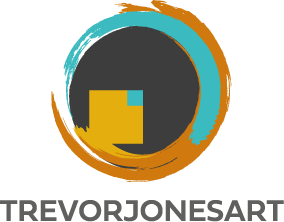A Brief Introduction to NFTs
As an artist whose mission for over a decade has been to explore the meeting of art and technology, Trevor was well-placed to become an early adopter of NFTs, which have revolutionised the ownership and trading of digital art. Since the world of NFTs is still unfamiliar to a lot of people, we wrote this brief introduction to help newcomers navigate their first steps.
NFT stands for non-fungible token, but that term isn’t much help in understanding them for most people. Think of NFTs as a way for people to buy, own, and sell things that exist digitally, rather than physically. Digital artwork, music tracks, event tickets, and customer loyalty programmes are common examples of things that can be owned and traded in this way. In Trevor’s case, while he usually begins each artwork by creating a painting on canvas (which can be bought, owned, and sold in the familiar ways), he then uses photography to derive digital images from the painting. These digital images, often with added animation and music, can be minted as NFTs.
NFTs exist on a technology known as a blockchain. A blockchain is a digital ledger – a record of transactions – which exists on the internet and records cryptocurrency transactions. Cryptocurrencies are forms of digital currency, alternatives to the dollars, pounds, or euros with which we are all familiar. Blockchains and cryptocurrencies are (for the most part) decentralised, meaning they are not administered by any individual, bank, or government. Holders of cryptocurrencies and NFTs manage, store, and transact their assets using a software or hardware tool called a crypto wallet. Popular examples are Coinbase Wallet, Ledger, and Trezor.
Bitcoin is the cryptocurrency of the first blockchain to have been created, and it is the best-known. However, the majority of NFTs are created using an alternative blockchain called Ethereum, although there are also many others that support NFTs. The process of creating an NFT on a blockchain is known as minting, and the process of minting usually incurs a payment known as a gas fee (that is just what it’s called – it has nothing to do with physical gas or gasoline). If you would like a bit more more information on blockchain, please see our article here. And for more information on gas fees, we have created this article.
There are a growing number of online marketplaces where NFTs can be browsed, bought, and sold. A few examples are OpenSea, Makersplace, and Nifty Gateway. Payments on these marketplaces are made in cryptocurrency – commonly ether, which is the currency of the previously mentioned Ethereum blockchain. When an NFT is purchased, the sale is recorded on the blockchain showing proof of the sale and ownership transference from the seller to the buyer’s crypto wallet. The new owner may then choose to display their NFT artwork, for example on their phone, in a virtual reality environment such as OnCyber, or in a digital frame in the real world such as those sold by Muse Frame.
If you would like to learn how to buy some cryptocurrency – perhaps to use it to purchase your first NFT – take a look at our Brief Guide to Buying Cryptocurrency.
As the NFT world uses a lot of jargon, here is a brief reminder of the most important terms used above:
- Bitcoin – the cryptocurrency of the first blockchain
- Blockchain – a decentralised online record of transactions in cryptocurrency
- Crypto wallet – a software or hardware tool that securely stores, manages, and allows transactions with cryptocurrencies.
- Cryptocurrency – a decentralised digital currency
- Decentralised – not administered by an individual, bank, or government
- Ether – the cryptocurrency commonly used in the minting of NFTs
- Ethereum – the most common blockchain with which NFTs are created
- Gas fee – the cost of minting an NFT
- Genesis – an artist’s first NFT
- Minting – the process of creating an NFT on a blockchain
- NFT (non-fungible token) – a technology that allows people to own and trade digital items, such as digital art
- NFT marketplace – a website where NFTs can be browsed, bought, and sold
